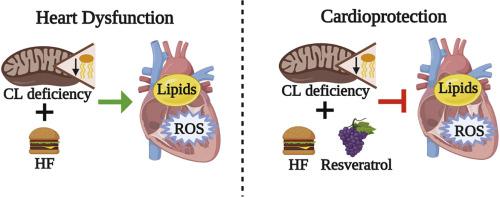当前位置:
X-MOL 学术
›
J. Mol. Cell. Cardiol.
›
论文详情
Our official English website, www.x-mol.net, welcomes your feedback! (Note: you will need to create a separate account there.)
Cardiolipin deficiency elevates susceptibility to a lipotoxic hypertrophic cardiomyopathy.
Journal of Molecular and Cellular Cardiology ( IF 5 ) Pub Date : 2020-05-11 , DOI: 10.1016/j.yjmcc.2020.05.001 Laura K Cole 1 , Edgard M Mejia 2 , Genevieve C Sparagna 3 , Marilyne Vandel 1 , Bo Xiang 1 , Xianlin Han 4 , Nikolaos Dedousis 5 , Brett A Kaufman 5 , Vernon W Dolinsky 1 , Grant M Hatch 6
Journal of Molecular and Cellular Cardiology ( IF 5 ) Pub Date : 2020-05-11 , DOI: 10.1016/j.yjmcc.2020.05.001 Laura K Cole 1 , Edgard M Mejia 2 , Genevieve C Sparagna 3 , Marilyne Vandel 1 , Bo Xiang 1 , Xianlin Han 4 , Nikolaos Dedousis 5 , Brett A Kaufman 5 , Vernon W Dolinsky 1 , Grant M Hatch 6
Affiliation

|
Cardiolipin (CL) is a unique tetra-acyl phospholipid localized to the inner mitochondrial membrane and essential for normal respiratory function. It has been previously reported that the failing human heart and several rodent models of cardiac pathology have a selective loss of CL. A rare genetic disease, Barth syndrome (BTHS), is similarly characterized by a cardiomyopathy due to reduced levels of cardiolipin. A mouse model of cardiolipin deficiency was recently developed by knocking-down the cardiolipin biosynthetic enzyme tafazzin (TAZ KD). These mice develop an age-dependent cardiomyopathy due to mitochondrial dysfunction. Since reduced mitochondrial capacity in the heart may promote the accumulation of lipids, we examined whether cardiolipin deficiency in the TAZ KD mice promotes the development of a lipotoxic cardiomyopathy. In addition, we investigated whether treatment with resveratrol, a small cardioprotective nutraceutical, attenuated the aberrant lipid accumulation and associated cardiomyopathy. Mice deficient in tafazzin and the wildtype littermate controls were fed a low-fat diet, or a high-fat diet with or without resveratrol for 16 weeks. In the absence of obesity, TAZ KD mice developed a hypertrophic cardiomyopathy characterized by reduced left-ventricle (LV) volume (~36%) and 30-50% increases in isovolumetric contraction (IVCT) and relaxation times (IVRT). The progression of cardiac hypertrophy with tafazzin-deficiency was associated with several underlying pathological processes including altered mitochondrial complex I mediated respiration, elevated oxidative damage (~50% increase in reactive oxygen species, ROS), the accumulation of triglyceride (~250%) as well as lipids associated with lipotoxicity (diacylglyceride ~70%, free-cholesterol ~44%, ceramide N:16-35%) compared to the low-fat fed controls. Treatment of TAZ KD mice with resveratrol maintained normal LV volumes and preserved systolic function of the heart. The beneficial effect of resveratrol on cardiac function was accompanied by a significant improvement in mitochondrial respiration, ROS production and oxidative damage to the myocardium. Resveratrol treatment also attenuated the development of cardiac steatosis in tafazzin-deficient mice through reduced de novo fatty acid synthesis. These results indicate for the first time that cardiolipin deficiency promotes the development of a hypertrophic lipotoxic cardiomyopathy. Furthermore, we determined that dietary resveratrol attenuates the cardiomyopathy by reducing ROS, cardiac steatosis and maintaining mitochondrial function.
中文翻译:

心磷脂缺乏症增加了对脂毒性肥厚型心肌病的敏感性。
心磷脂(CL)是一种独特的四酰基磷脂,定位于线粒体内膜,是正常呼吸功能所必需的。先前已经报道,衰竭的人心脏和几种啮齿动物心脏病理模型具有选择性的CL丧失。由于心磷脂水平降低,一种罕见的遗传病Barth综合征(BTHS)同样具有心肌病的特征。最近,通过敲低心磷脂生物合成酶他法津(TAZ KD),开发了心磷脂缺乏症的小鼠模型。这些小鼠由于线粒体功能障碍而发展出年龄依赖性的心肌病。由于心脏中线粒体能力的降低可能促进脂质的积累,因此我们检查了TAZ KD小鼠中的心磷脂缺乏是否促进了脂毒性心肌病的发展。此外,我们调查了用白藜芦醇(一种小型的心脏保护性保健药物)治疗是否能减轻异常的脂质蓄积和相关的心肌病。对缺乏他沙巴星和野生型同窝幼仔对照的小鼠喂养低脂饮食,或高脂饮食加白藜芦醇或不加白藜芦醇,持续16周。在没有肥胖的情况下,TAZ KD小鼠发展为肥厚型心肌病,其特征是左心室(LV)体积减少(〜36%),等容收缩(IVCT)和舒张时间(IVRT)增加30-50%。缺乏tafazzin的心脏肥大的进展与几种潜在的病理过程有关,包括线粒体复合体I介导的呼吸改变,氧化损伤增加(活性氧增加约50%,ROS),与低脂喂养对照组相比,甘油三酯(〜250%)的积累以及与脂毒性相关的脂质(二酰甘油〜70%,游离胆固醇〜44%,神经酰胺N:16-35%)。用白藜芦醇治疗TAZ KD小鼠可维持正常的LV容量并保留心脏的收缩功能。白藜芦醇对心脏功能的有益作用伴随着线粒体呼吸,ROS产生和心肌氧化损伤的显着改善。白藜芦醇治疗还可以通过减少从头脂肪酸合成来减轻他巴辛缺乏症小鼠心脏脂肪变性的发展。这些结果首次表明心磷脂缺乏促进肥厚性脂毒性心肌病的发展。此外,
更新日期:2020-05-11
中文翻译:

心磷脂缺乏症增加了对脂毒性肥厚型心肌病的敏感性。
心磷脂(CL)是一种独特的四酰基磷脂,定位于线粒体内膜,是正常呼吸功能所必需的。先前已经报道,衰竭的人心脏和几种啮齿动物心脏病理模型具有选择性的CL丧失。由于心磷脂水平降低,一种罕见的遗传病Barth综合征(BTHS)同样具有心肌病的特征。最近,通过敲低心磷脂生物合成酶他法津(TAZ KD),开发了心磷脂缺乏症的小鼠模型。这些小鼠由于线粒体功能障碍而发展出年龄依赖性的心肌病。由于心脏中线粒体能力的降低可能促进脂质的积累,因此我们检查了TAZ KD小鼠中的心磷脂缺乏是否促进了脂毒性心肌病的发展。此外,我们调查了用白藜芦醇(一种小型的心脏保护性保健药物)治疗是否能减轻异常的脂质蓄积和相关的心肌病。对缺乏他沙巴星和野生型同窝幼仔对照的小鼠喂养低脂饮食,或高脂饮食加白藜芦醇或不加白藜芦醇,持续16周。在没有肥胖的情况下,TAZ KD小鼠发展为肥厚型心肌病,其特征是左心室(LV)体积减少(〜36%),等容收缩(IVCT)和舒张时间(IVRT)增加30-50%。缺乏tafazzin的心脏肥大的进展与几种潜在的病理过程有关,包括线粒体复合体I介导的呼吸改变,氧化损伤增加(活性氧增加约50%,ROS),与低脂喂养对照组相比,甘油三酯(〜250%)的积累以及与脂毒性相关的脂质(二酰甘油〜70%,游离胆固醇〜44%,神经酰胺N:16-35%)。用白藜芦醇治疗TAZ KD小鼠可维持正常的LV容量并保留心脏的收缩功能。白藜芦醇对心脏功能的有益作用伴随着线粒体呼吸,ROS产生和心肌氧化损伤的显着改善。白藜芦醇治疗还可以通过减少从头脂肪酸合成来减轻他巴辛缺乏症小鼠心脏脂肪变性的发展。这些结果首次表明心磷脂缺乏促进肥厚性脂毒性心肌病的发展。此外,



























 京公网安备 11010802027423号
京公网安备 11010802027423号